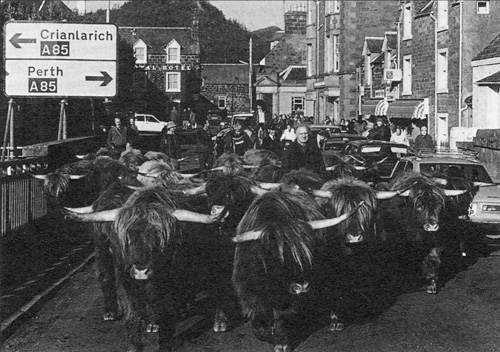


The History of Highland Cattle
Highland Cattle are an old breed known to have grazed the rugged Scottish landscape since the sixth century. It is still a matter of debate as to whether they were an origin of Scotland or imported from Scandinavia perhaps with the Vikings when they invaded Great Britain.
The origins of the ancient breed of Highland Cattle are therefore the subject of speculation (albeit educated speculation). The theory expounded by Mr. Michael Fennell gains wide acceptance amongst Highland breeders.
Michael believes that Highland Cattle are the results of the blending of two ancient Asiatic breeds, the 'Bos Longifrons' and the 'Bos Primigenius'.
The Longifrons giving them the long horns and the Primigenius giving them their hairy looks. Both breeds had migrated from the Far East and Mongolia to the region of the Black Sea. The evolving breed migrated slowly west and north to the Baltic shores approximately 6000 years ago.
From there emigration to the Highlands and Islands of Scotland was a very small step. Michael believes that it is possible that the Scando - Celt may have released the breed in the Highlands of Scotland in an effort to keep their own herd numbers under control.
Whatever the source and cause of migration there can be no doubt that Highland Cattle played a significant part in the development and civilisation of the Highlands of Scotland.
The cattle have for generations been a source of meat and milk for the "Crofters", small farmers of the high country who lived principally by fishing and by subsistence agriculture. The hair too was useful in the process of spinning yarn. The calves were bought and sold at the annual trysts or cattle sales.
The most famous of the Trysts took place in Stirling, Scotland. Cattle from the Islands were swum ashore and herded along ancient drove roads to Stirling. Often after the sale they were driven south on the drove roads to England for resale.
In the days of the drove roads and the Stirling Trysts most of the Highland Cattle were black. The black highlanders which were found mainly on the Islands were referred to as Kyloes. They tended to be small, very hardy but slow to develop, so it is not surprising that they have been superseded by the larger framed red animals of the mainland. (Modern breeding practices have virtually eliminated any genetic variation associated with colour)
In 1884 when the Scottish Highland Cattle Society was formed most of the animals registered in the early herd books were black. The first herd book contained only bulls (561), the second 866 pedigree cows and 63 bulls and the third a record of awards to Highland Cattle at shows of the Highland and Island Agricultural Society from 1822 - 1884.
Over the years, societies have also been formed in Canada, USA, Sweden, Denmark, Germany, Australia and New Zealand.

Thought to be a painting of a Drove through Callander, Perthshire in the 1870's on the way to the autumn Falkirk Tryst

Over 100 years later in the 1980's Drovers took the historic route to prove modern cattle were just as able to withstand the rigours of the journey as their ancestors. The photo shows the cattle on their way to Crieff, with only 5 miles to go, after a 180 mile journey from the Isle of Skye.

